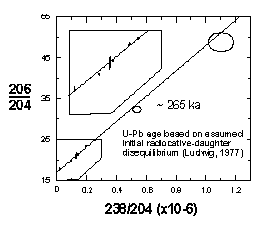
Important information about past climates and landscape evolution can be obtained from speleothems (cave stalactites, stalagmites). However, the limited range of 230Th/238U dating techniques (< 500 ka) means that many potentially important geological samples of Quaternary and Tertiary age remain undated. The same is true of peat deposits, to which only radiocarbon (< 60 ka) and 230Th/238U techniques (Heijnis and van der Plicht, 1992) are applicable. U-Pb dating techniques are commonly used for materials ranging in age from a few million years to the age of the earth. Here we assess the application of U-Pb methodology to much younger deposits.
We demonstrate that a stalactite from Winnats Head Cave in the Peak District, England, previously analysed by 230Th/238U methods (Ford et al., 1983), can potentially be dated using U-Pb methodology. Sub-millimetre wafers, almost entirely composed of clear calcite with a small detrital component, were analysed by TIMS for U and Pb. The calcite phase has high U (16-30 µg g-1), and low
Pb (< 10 ng g-1). Using the preliminary Pb isotopic
results plotted below, we obtain an initial 206Pb/204Pb ratio of 17.11 ± 0.04, identical to the measured detrital, low-m phase 206Pb/204Pb, 17.17 ± 0.09. The large range of m values obtained (800 to 1.2 x 106) enables 206Pb*/238U and 207Pb*/235U to be estimated with reasonable precisions (~3% and ~10%, respectively; 2s). Using the independently estimated initial (234U/238U) and assuming negligible initial 231Pa, 227Ac, 230Th, 226Ra, 210Pb, near-concordant ages of ~265 ± 5 ka and ~310 ± 30 ka (minimum 2s errors) have been derived as a first approximation (Ludwig, 1977). These are somewhat older than the 230Th/238U age of 186 ± 14 ka (2s) and possible causes of systematic bias are being investigated.
U-Pb methodology can also potentially be applied to ancient peat deposits if the system remains closed for intermediate daughters between 238U and 206Pb post deposition. Results for the Nar Valley freshwater peat deposit, East Anglia (314 ± 9 ka by 230Th/238U methods; Rowe and Atkinson, in prep.) with relatively low Pb (0.6-1.6 µg g-1) and high U (14-50 µg g-1) will be discussed.
Overall the results on both sample types are promising and a detailed investigation of U-Pb systematics in these young systems is continuing.
Ford, T.D., Gascoyne, M. & Beck, J.S., Cave Sci. 10, 103-115 (1983).
Heijnis, H. & van der Plicht, J., Chem. Geol. 94, 161-171 (1992).
Ludwig, K., Jour. Res., U.S. Geol. Surv. 5, 663-667 (1977).
Rowe, P.J. & Atkinson, T.C., (in prep).